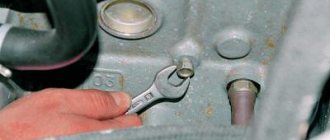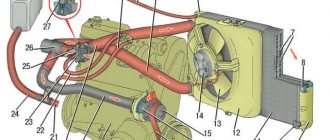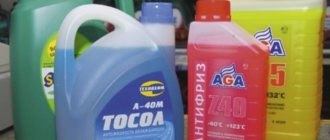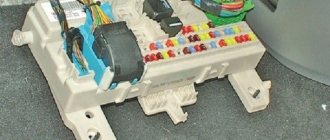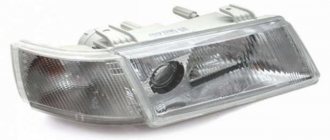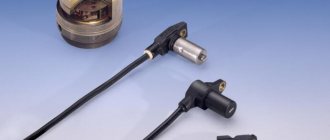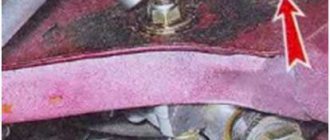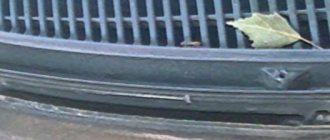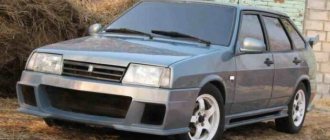Over time, every car owner thinks about replacing antifreeze, since this liquid also has an expiration date. Please note: antifreeze containing ethylene glycol is poured into a Chevrolet Lanos car. Prohibited: antifreeze and water.
Replacing Chevrolet Lanos antifreeze is done after driving more than 40 thousand kilometers or 4 years of using the car. You can carry out the process earlier if you see that the antifreeze has darkened or a pronounced dark shade has appeared. An urgent replacement is required.
The car's passport provides for 7 liters in the cooling system. However, according to many years of experience of many car owners, no more than 5 will be required, since the cooling system cannot be completely freed from antifreeze due to design features.
To change the coolant, place the vehicle on a level surface and let it stand until the coolant in the system cools.
Step 1 First, look for the plug on the radiator located on the left and unscrew it.
We place the necessary container under it to drain the antifreeze, and unscrew the cap of the expansion tank.
Step 2 As a result of the fact that there is no drain plug on the Chevrolet Lanos, it will not be possible to completely replace the coolant. But it’s still worth trying to drain the maximum amount of liquid. To do this, use a jack to lift either the front or rear axle. Thanks to this procedure, it was possible to drain about half a liter of liquid.
Step 3 If the tank is clogged, remove it and clean it thoroughly.
Step 4 After completing the previous steps, replace the new coolant, bringing the level to the maximum mark indicated on the tank. We start the power unit and wait until the fan starts working.
Tip: To prevent air from entering the system, press the radiator hoses with your hands when filling.
Step 5 Stop the engine and check the coolant level. If necessary, add to recommended level.
Sometimes there are problems with coolant leaks in the car model in question. The main factors are:
- The antifreeze level is below the permissible level.
- Radiator problems.
- Air lock when filling.
- Loose hose fastenings.
However, there may be completely different problems. Each case is examined personally. If you are unable to fix a coolant leak, contact our service center directly, who will help you fix the problem using a variety of tools and years of experience.
If everything is in order and there are no leaks, we enjoy replacing the coolant. The engine will cool much faster than it did with the previous antifreeze.
Subscribe
to our channel in
Index.Zen
Even more useful tips in a convenient format
I decided to replace the coolant in my car and was faced with the question: What kind of antifreeze should I fill in? To clarify this issue, I open the Lanos car operating manual, in the “Operating materials” section I find: coolant - ethylene glycol liquid with distilled water in a ratio of 50/50 or 60/40, comprehensive information...)
Sellers offer a wide range and the first thing they are interested in is: “What color antifreeze is needed?” I had to delve into the question, I’ll try to summarize the information received... From what I read, I learn that when choosing antifreeze, you need to be guided not by the color, but by the information on the canister. The composition of the additives is the main difference in antifreeze. The addition of bright dyes is not done in order to distinguish antifreezes that are identical in composition.
How to find out what is in the cooling system of a car
Replacing antifreeze in a Chevrolet Lanos 1.5 is not a complicated procedure, but it is much more difficult to choose the appropriate coolant that will ensure efficient engine operation (meaning, it will ensure quick warming up of the engine in winter and cooling it in summer). Which coolant is best to fill into a car is described in detail in this material. Today we will learn how to determine what kind of coolant is poured into the cooling system of Lanos, Sense and Chance cars, how to determine the need for replacement, and also how to replace antifreeze with your own hands.
If you forgot or bought a car, but did not find out from the previous owner what type of refrigerant he used, then you can find out on your own. Two types of refrigerants are used as coolants - antifreeze and antifreeze. To find out what type of coolant is filled, you need to pay attention to the following factors:
- Resistance to frost - for this it is not necessary to wait for the arrival of cold weather.
Fill the bottle with some liquid from the expansion tank and place it in the freezer. If after 20-30 minutes the coolant does not freeze, then it is high-quality antifreeze. Freezing of the liquid indicates that low-quality antifreeze has been poured into the system. - Color -
antifreeze is painted blue, and coolant has different color options. If there is blue liquid in the tank, then there is a high probability that antifreeze is poured into the system. Few people know, but antifreeze was also produced in red color, and it had a crystallization temperature of -65 degrees. However, such liquids were not available for free sale, but were intended for use in harsh polar conditions. - Use a hydrometer - this is a special device for determining density.
The density of antifreeze ranges from 1.073 to 1.079 g/cm3, and antifreeze has a lower density.
Antifreeze, which was produced back in the 70s under the USSR, differed from modern analogues in its high quality. In addition to its resistance to boiling and crystallization, the antifreeze changed its color as the amount of additives was reduced. When the blue liquid became colorless, it meant it needed to be replaced. The production of high-quality antifreeze continued until the 90s, after which production was curtailed and closed. However, liquids with the name “Antifreeze” continued to be produced, but only at various enterprises in the Russian Federation.
Modern antifreeze manufacturers make it using inorganic compounds and other substances that do not meet standards. This leads to the fact that the liquids work for no more than 2 years, and have a low boiling point (up to 110 degrees). Based on the current historical situation with antifreeze, today many motorists prefer to use foreign analogues, which cannot be called wrong. Using one of the above methods, you can understand what exactly is poured into the Lanos cooling system.
How to change the coolant?
Let's take a closer look at how to replace antifreeze in Lanos with your own hands.
Required Tools
To replace you will need the following tools:
- pliers;
- screwdriver;
- 10mm wrench, it is better to use a socket wrench;
- a bucket or old basin into which the waste liquid will be drained (a cut-off five-liter bottle will do);
- a jack to raise the front of the car;
- a watering can or funnel, with its help you will carefully pour in the new “Antifreeze” (the cut off top of the bottle will also work).
How to drain?
Changing a consumable begins with draining it:
- It will not be possible to completely remove all the antifreeze from the system, but you should try to drain as much fluid as possible from the engine. To do this, the vehicle must be placed on a flat surface; it will be more convenient to drive it into a pit or overpass.
- Find the refrigerant drain plug on the radiator; it is located on the left, in the lower corner, as shown in the photo. Place a prepared container under the plug to collect used antifreeze. Unscrew the lid.
- After this, unscrew the filler cap located on the expansion tank.
- The draining process will begin. To quickly drain consumables from the system, you need to remove the pipe from the fitting located on the throttle. This pipe is removed from the throttle assembly using pliers or a screwdriver.
- You won’t be able to drain all the refrigerant, but you can try to minimize the remainder in the cooling system of the power unit. To do this, take a jack and use it to lift the rear right wheel.
1. Plug for draining antifreeze in the Lanosov radiator 2. Remove the pipe from the fitting for faster draining 3. Clean the expansion tank and flush the cooling system 4. Fill the tank with new coolant
Flushing
If the antifreeze has never been changed before or there are deposits in it, then the system must be flushed.
Otherwise, the dirt that remains in it will not allow the liquid to fully perform its functions. Water is used to flush the cooling system. Buy distilled water; tap water is not recommended. It contains substances and microorganisms that can lead to corrosion on metal elements of the system, for example, a radiator.
- Flushing is performed by tightening the plug on the radiator device with cream. About five liters of distillate are poured into the expansion tank. Water flows until it begins to flow out of the previously disconnected throttle pipe. When this happens, the pipe is put in place and the plug on the expansion tank is tightened.
- Now the car engine starts, it should run for 3-5 minutes.
- After this time, the water is drained from the cooling system. Assess the color and condition of the drained liquid - it will contain sediments and deposits, the color is usually brown. If the drained water is dirty, the washing process is repeated two to three more times. Flushing is done until the water drained from the system is as clean as possible.
- In practice, deposits also form in the cistern. Remove it using a 10mm wrench and rinse the container with clean water.
How to fill coolant correctly?
When draining and flushing are completed, new refrigerant is added. The drain plug is screwed in, the pipe from the throttle is installed in place. When pouring liquid, antifreeze must be added to the maximum mark on the tank body. To speed up this procedure, when filling, you should press the hoses of the radiator device with your hands from time to time. This will avoid the occurrence of air locks in the system. When the filling is completed, the power unit is started for a few minutes, then switched off. This is done to diagnose the refrigerant level in the expansion tank - it should decrease. If this happens, then the liquid is again added almost to the MAX mark.
Below is a detailed video instruction on how to independently replace the refrigerant in Lanos from the Garage TV channel.
How to determine the need to replace the coolant on Lanos
Information on how often you need to change the coolant on your car is very useful. However, it is not always relevant, since few car owners remember when the last replacement was made. To determine whether it is time to change antifreeze on Lanos, Sense and Chance, you need to rely on some methods.
This is interesting!
The service life of the coolant depends not only on the manufacturer’s recommendations, but also on the quality and type of coolant, as well as the material of the radiators used. For comparison, the manufacturer of Lanos, Sense and Chance cars recommends replacing the coolant every 40,000 km or 3-4 years, while Volkswagen gives a lifetime service life.
Today, manufacturers are producing a new generation of antifreeze, the service life of which has been increased to 200 thousand km. This resource is determined by the presence of anti-corrosion additives. It is not rational to buy such an expensive refrigerant for a budget car, so when using antifreeze, it should be changed every 3-4 years.
You can determine the need to replace antifreeze on Lanos by the state of the refrigerant. The liquid must be clean and free of dirt, rust and other deposits. If the condition of the fluid is not satisfactory, it should be replaced and the system flushed. It is recommended to change directly to the type of fluid that was poured into the system from the factory. You can find out the type of fluid in the technical documentation for the car. However, finding a similar brand of refrigerant can be problematic, so we use the most suitable type of coolant.
How much antifreeze does the cooling system of Chevrolet and Daewoo Lanos hold?
Before you replace the coolant with Lanos 1.5, you will need to initially purchase the required amount of refrigerant. For each car model, the amount of coolant is different. The required amount of antifreeze is indicated directly in the technical documentation for the car.
The capacity of the cooling system for Lanos, Sense and Chance is 7 liters. This is exactly the amount of coolant that will need to be purchased in advance before replacing it. However, during the replacement process, you may encounter the fact that some of the liquid being poured will remain - approximately 1.5-2 liters. This is due to the fact that it is almost impossible to drain all the liquid from the system. That is why 5 liters of new antifreeze (3.5 liter concentrate) is enough, poured into the engine cooling system of Chevrolet, Daewoo and ZAZ Lanos.
What antifreeze to pour into the engine cooling system of Lanos, Sens and Chance
Today there are a large number of types of coolants on the market. Which type of coolant is best to choose depends on many factors. To decide which antifreeze to pour into the Lanos engine cooling system, you should familiarize yourself with this material, on the basis of which you can make the right decision.
Experts recommend pouring antifreeze into Lanos of the same brand that was originally filled from the factory. In this case, you won’t even need to flush the system first. If a different brand of antifreeze is selected (in most cases), then a system flushing procedure is carried out before replacement.
What is needed to replace antifreeze on Chevrolet and Daewoo Lanos
Before carrying out work on replacing antifreeze and antifreeze on Lanos, you should make sure that you have the necessary tools. The replacement procedure is not difficult, and there is no need to go to a car service center to carry out the replacement. Even a beginner can cope with this task by first preparing the necessary equipment, materials and tools. To replace the refrigerant on Lanos, you should make sure you have the following tools:
- Set of keys and screwdrivers
- Pliers
- Jack
- A container for draining old fluid of at least 5 liters. Draining refrigerant into the ground is strictly prohibited, as this is harmful to the environment. After draining the liquid into the container, it should be disposed of. Antifreeze contains ethylene glycol, which contributes to the development of cancer.
The materials you will need are antifreeze or antifreeze in the required quantity. If the antifreeze is not diluted, then distilled water is purchased separately. To flush the system, you will need a can of special liquid (reagent), which is poured into the system, mixed with the old refrigerant.
Considering the fact that 1.5-2 liters of water remains in the system after draining, which is due to the design of the engine system, when using concentrate you will need to dilute it in the following amount:
- Mix 3.5 liters of concentrate with 1.5 liters of distilled water
- You cannot use ordinary water to dilute the concentrate, as it freezes at subzero temperatures.
When all the preparatory work has been completed, all that remains is to begin the relevant replacement work. First, let's look at how to flush the engine cooling system on Lanos.
Replacement process
Replacing antifreeze in a Chevrolet Lanos can be done with your own hands. To do this, you need to figure out what tools are needed for replacement, how to drain the antifreeze, flush the system and fill in new fluid.
Necessary tools and preparation for replacement
To begin the process of replacing antifreeze for Chevrolet Lanos, you should prepare the following tools:
- Screwdriver;
- Pliers;
- 10mm wrench (preferably use a socket wrench);
- An empty container of sufficient size (basin or bucket) for draining waste liquid;
- Jack to raise the front of the vehicle;
- Watering can or funnel (for filling in new coolant).
How to drain antifreeze from a Chevrolet Lanos?
How to drain antifreeze from Lanos? To do this, you must follow the instructions:
- Place the car on a flat surface. The best option is to drive onto an overpass or pit;
- Find the drain plug on the radiator. It is located in the lower right corner, then unscrew it, having previously placed a container underneath, previously prepared for waste coolant;
- Unscrew the fluid filler cap. It is located on the antifreeze expansion tank. The process of draining the liquid has begun. To speed up this process, you can dismantle the pipe located on the throttle valve. To do this, you can use a screwdriver or pliers;
- It will not be possible to drain all the liquid, so you can try to empty the system as much as possible. To do this, use a jack to lift the rear right wheel.
How to pre-flush a car's cooling system
Before replacing antifreeze on Lanos, Sense and Chance, it is necessary to flush the system. This procedure is not at all mandatory, but it is recommended in the following situations:
- When the type of coolant changes, for example, if antifreeze has been added and it is planned to use antifreeze
- When changing the type of refrigerant, for example, if G11 antifreeze was previously filled, and it is planned to use G12 or G13
- If the refrigerant being drained is red in color and shows signs of blockages
The primary rinsing process involves performing the following manipulations:
- For flushing, a special liquid is used - a reagent, which is poured into the expansion barrel. Before adding flushing fluid, you need to warm up the engine to operating temperature.
- Add fluid and let the engine idle for at least 10-20 minutes.
- In this case, you should turn on the heater in the car to maximum in order to flush the heater radiator
After the engine has been running for 10-15 minutes, you can turn it off and begin draining and replacing the refrigerant. How to replace antifreeze on Chevrolet and Daewoo Lanos, we will consider in detail below.
This is interesting!
Some recommend flushing the system with reagents with ordinary or distilled water, which is poured into the system after draining the coolant. However, reagent manufacturers recommend mixing the composition with antifreeze or antifreeze, which improves flushing properties.
Why might antifreeze leak?
Briefly about the reasons why a coolant leak may occur:
- Leakage can be confused with a decrease in the volume of consumables; this always happens in winter. During the cold season at sub-zero temperatures, the refrigerant in the expansion tank loses a little volume.
- The appearance of cracks and other damage on the tank. Detecting these defects, especially if they are minor, is not so easy. Sometimes they are not visible and look like scratches. Minor damage can be repaired by cold welding. If the cracks are serious, then the expansion tank must be replaced.
- The connections of the cooling system pipes have become depressurized. This is often due to loose clamps. These elements need to be tightened or replaced.
- Damage to hoses and pipes. They wear out as a result of long-term use or mixing of different types of antifreeze. The simultaneous use of coolants of different compositions can lead to a chemical reaction that has an aggressive effect on the rubber elements of the system - pipes and hoses. Damaged lines must be replaced.
- The thermostat gasket is worn out. Usually, when the gasket wears out, the thermostat itself changes, since the service life of these elements is the same. It is advisable to change the thermostat.
- Malfunctions in the operation of the radiator device. If the radiator is leaking, you can try to repair it using cold or argon welding. But this rarely helps; usually the radiators are simply changed.
- The leak may be due to antifreeze getting into the engine oil. This problem is the most serious and occurs as a result of damage to the cylinder head gasket or the cylinder head itself. You will have to remove the head and carry out detailed diagnostics of the unit. A damaged gasket must be replaced.
What are the signs to identify a leak?
- while driving, smoke came out from under the hood of the Lanos;
- after starting the engine, white steam comes out of the car's exhaust pipe;
- the stove does not work well, does not heat, but only cools;
- an engine fault indicator appeared on the dashboard;
- the temperature sensor needle has risen to the maximum;
- the car interior smells of antifreeze due to a leak in the heater radiator;
- a puddle appeared under the front seat mat.

